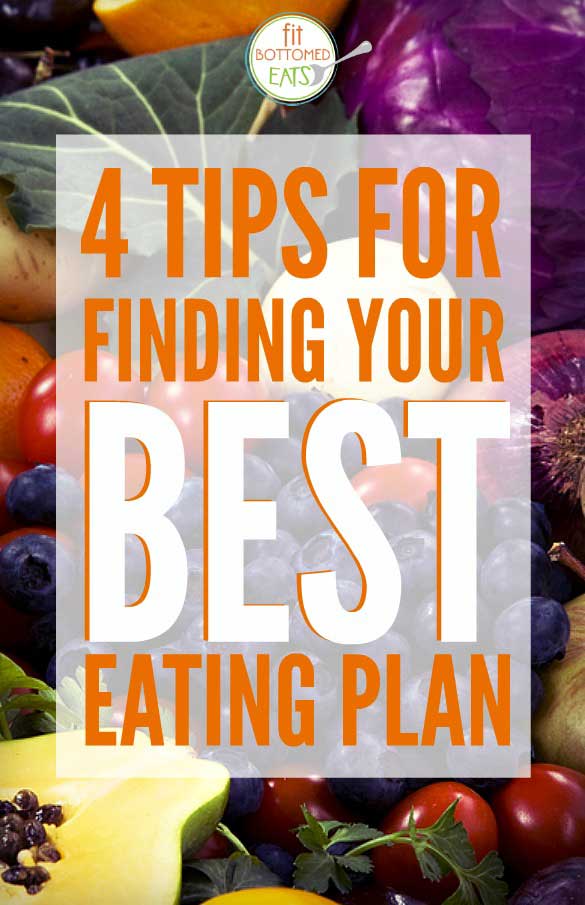4 Tips for Finding Your Best Eating Plan
Confused by all the healthy eating trends? Wanting to find YOUR best eating plan? Chanda Guerin is here to share how to do just that. A health and nutrition education masters of science candidate who enjoys yoga, hiking and farmers’ markets, Chanda is also a food blogger and child nutrition enthusiast. Her recipes, rants about current diet trends, and lusty thoughts of Cheetos and Pepsi can be found at LoveandAPinchofSalt.com.

Depending on who you follow on Facebook, the latest Michael Pollan publication, writers in the blogosphere or forwarded emails from friends, it seems there is a never-ending list of foods that are better, the best, the only way, and a matter of life or death in your choosing. In every food and diet conversation there is this ominous “they” who seem to know what’s best for you and its application to every other person listening. Don’t eat red meat! Bacon is great! Grains will make you bloat! Soy is terrible! Count calories! Drink raw milk! Cheetos are great! ONLY eat organic!
Ah! Seriously, who am I supposed to listen to and believe?! They all have different answers and reasoning, and their so-called solutions contradict each other. Am I healthy if I’m a vegetarian? I can’t eat full-fat dairy…can I? Who has the right answer?
My friend, AP, follows the Paleo eating plan (as does Jenn), and I’m a vegetarian who sometimes eats chicken and fish. AP is a member of a CrossFit gym and has discovered a community bond over fitness and Paleo-eating with her gym-mates. They share a love of bacon and all things declared caveman—like by Robb Wolf and the Weston A. Price Foundation. Then there’s me—the veg-head friend studying holistic nutrition, who hasn’t consumed red meat or pork in 12 years, and The China Study is my bible. I eat legumes and quinoa like a champ. She shudders at the thought of black beans and wild rice dancing around in my belly.
Red meat destroys my stomach: awful, achy cramps and days away from any healthy digestive processes. The same thing happens to her with pasta and cheese, but I can eat both without any trouble. In holistic nutrition, we call this biochemical individuality—the idea that every individuals’ genetics, level of exercise and activity, and daily stressors vary, making their dietary needs different. Lactose intolerance, increased levels of protein for workouts and natural metabolism are factors AP balances when making food choices. She’s jumping on boxes and throwing weights my person-size around the gym six days a week. I’m meditating, holding Iyengar poses and walking around the city. Two people who passionately care for their well-being, health and long-term care of their physical body are following two very different eating plans.
Here’s the magic answer you’re waiting for: The best eating plan is one that adjusts to your individual biological needs and lifestyle. Find what works for your body and lifestyle, and go for it. Here are four tips for discovering foods and the best eating plan for you.
How to Find Your Best Eating Plan
1. Listen to your body. Do you suffer from acid reflux after a bowl of spaghetti or end up in the bathroom after a slice or two of four-cheese pizza? Catch what your body’s throwin’ and limit your intake of foods that trigger these reactions, rather than reaching for the medicines to cover up food intolerance symptoms.
2. Choose whole foods and limit/eliminate processed food items. Your body knows how to use whole foods as fuel to balance blood sugar, energy levels and digestion. Whether its fruit, vegetables, animal foods, dairy or beans, your body knows how to break down these whole foods. Artificial flavorings and colorings, preservatives, additives and sugar-alternatives are foreign food items your body will take more energy to try to break down instead of using it for the fuel it needs to keep you moving.
3. Educate yourself. Check out books from the library, borrow literature from friends, surf the Internet for reliable sources or place an order with Amazon for the latest reads on nutrition and healthful eating. You could decide to eat sugar-free, carbs for athletes, vegetarian, Paleo, or, gasp, even vegetarian Paleo. Every piece of information you pick up will lead you toward forming your own ideas, thoughts and opinions.
4. Support those around you and practice grace. Be prepared for people to not agree with the way you eat. Diet and food are emotional topics for people as the food industry and agriculture are constantly under a microscope and more people are suffering from food and nutrition-related diseases and disorders. Practice grace by supporting your friends, family and coworkers in making health-positive choices. My favorite synonym for “grace” is “loveliness.” Be loving and share your mutual passion for food and health by cooking for each other and/or together.
How are you discovering the best eating plan for you and supporting your fellow Fit Bottomed Eats peeps? —Chanda
